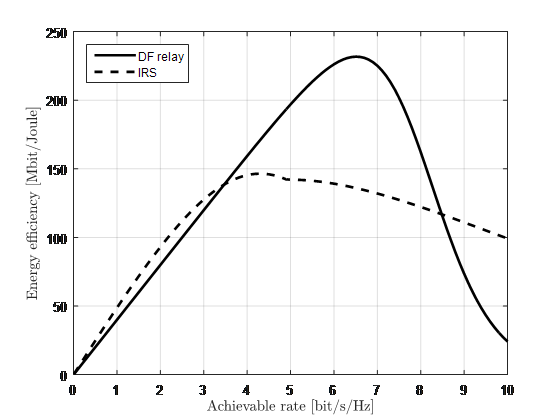When the IoT Meets IRS: Intelligent Reflecting Surfaces for Massive IoT Connectivity
The concept of Intelligent Reflecting Surface (IRS) has emerged as a transformative and revolutionary technology for providing seamless coverage and to achieve energy and spectrum efficiency for cost-effective wireless networks.
The architecture of the IRS comprises of arrays of passive and reconfigurable antenna elements printed on a low-cost substrate [1]. Each element in the IRS structure is equipped with a phase shifter to control the transmission of the incident signal [2]. The IRS reflects the incident plane wave in the form of a beam in the desired direction by adjusting the phase difference between each passive element [3]. Although the IRS itself is in the infancy phase, its applications and utility in other domains are growing exponentially.
Using IRS for the Internet of Things (IoT)?
Typically, the Internet-of-things (IoT) applications range from monitoring services in remote locations to continual sensing of the environment [4]. However, the limited power of such IoT devices restraint the transmission range. The monitoring services can be implied in different industries, which may vary from health management using wearable devices, tackling emergencies in disaster scenarios, etc. requires information to be uploaded without being lost. To effectively handle such situations, the key property of IRS, i.e., coverage enhancement, may be helpful for enhancing the functionality of IoT devices. Therefore, for the uninterrupted operations of IoT devices with improved coverage, the use of the IRS with the IoT is one of the cost-effective and feasible options.
IRS Replacing the Relays in IoT Networks?
Due to the low-power nature of IoT devices, relays provide an alternative path (non-line of sight) to overcome the channel impairments that occurred due to the presence of obstacles between the source and the destination device. There are several protocols of relay communication, e.g., amplify-and-forward, decode-and-forward, compress-and-forward, etc. The presence of relays provides an additive advantage to the IoT network and brings an exponential increase in the performance. However, there are some disadvantages to using them, which are often overlooked. We have pointed out the following key issues that may arise due to the presence of relays in the IoT network;
- The amount of interference in the IoT network may increase by adding an excessively large number of relay devices [5].
- Optimal deployment of relays in the IoT networks plays a critical role and, hence, affects the coverage. Generally, the requirement of the relays increases the overall cost of the IoT network.
- Some relay protocols require decoding the signal prior to the retransmission. This kind of relaying techniques may impact the privacy of the IoT devices and make them vulnerable to attacks.
- Relays require a permanent source of power to perform their operations which may result in increasing the power budget of the IoT network.
IRS can be considered as a complementary technology to overcome cost, security, power, and energy efficiency issues by providing more control over the single propagation using software-controllable reflections, omitting the need to perform decoding of the signal [6]. Looking from the IoT perspective, the devices which are IoT enabled having power constraint can be benefitted from the IRS. For instance, the authors in [7] compare the performance of a network-enabled with a decode-and-forward relaying protocol against the network. It was claimed that an IRS-enabled network can achieve higher energy efficiency in comparison to decode-and-forward relay for very high data rates and it has been shown in [7] using the following figure.

Figure 1: Comparison of energy efficiency vs. data rate for IRS and decode-and-forward relaying.
Future of IRS
The merger of IRS in IoT networks is still a new and less-evolved area of communications. However, it has the potential to open new avenues and provide massive opportunities for the research community. We hope that the above discussion will open a new chapter in the domain of the IRS and would provide useful guidance for investigating future IoT networks. The power constraint among the IoT devices can be optimized by using the IRS technology, hence it would be critical for improving their functionality.
References
- Liaskos, S. Nie, A. Tsioliaridou, A. Pitsillides, S. Ioannidis and I. Akyildiz, "A New Wireless Communication Paradigm through Software-Controlled Metasurfaces," in IEEE Communications Magazine, vol. 56, no. 9, pp. 162-169, Sept. 2018.
- Wu and R. Zhang, "Intelligent Reflecting Surface Enhanced Wireless Network via Joint Active and Passive Beamforming," in IEEE Transactions on Wireless Communications, vol. 18, no. 11, pp. 5394-5409, Nov. 2019.
- M. Pozar, S. D. Targonski and H. D. Syrigos, "Design of millimeter wave microstrip reflectarrays," in IEEE Transactions on Antennas and Propagation, vol. 45, no. 2, pp. 287-296, Feb. 1997.
- Al-Fuqaha, M. Guizani, M. Mohammadi, M. Aledhari and M. Ayyash, "Internet of Things: A Survey on Enabling Technologies, Protocols, and Applications," in IEEE Communications Surveys & Tutorials, vol. 17, no. 4, pp. 2347-2376, Fourthquarter 2015.
- Wang, W. Chen, H. Tang and Q. Wu, "Joint Optimization of User Association, Subchannel Allocation, and Power Allocation in Multi-Cell Multi-Association OFDMA Heterogeneous Networks," in IEEE Transactions on Communications, vol. 65, no. 6, pp. 2672-2684, June 2017.
- Tan, Z. Sun, D. Koutsonikolas and J. M. Jornet, "Enabling Indoor Mobile Millimeter-wave Networks Based on Smart Reflect-arrays," IEEE INFOCOM 2018 - IEEE Conference on Computer Communications, Honolulu, HI, 2018, pp. 270-278
- Bj ̈ornson, ̈O. ̈Ozdogan, E. G. Larsson, Intelligent reflecting surface vs. decode-and-forward: How large surfaces are needed to beat relaying?, arXiv: 1906.03949.
- Subrt and P. Pechac, "Controlling propagation environments using Intelligent Walls," 2012 6th European Conference on Antennas and Propagation (EUCAP), Prague, 2012, pp. 1-5.
- Basar, "Transmission Through Large Intelligent Surfaces: A New Frontier in Wireless Communications," 2019 European Conference on Networks and Communications (EuCNC), Valencia, Spain, 2019, pp. 112-117.
 Muhammad Ali Jamshed received his B.Sc. degree in Electrical Engineering from COMSATS University, Islamabad, Pakistan, in 2013 and the M.Sc. degree in Wireless communications from the Institute of Space Technology, Islamabad Pakistan, in 2016. He is currently with the Institute for Communication Systems (ICS), 5G Innovation Centre (5GIC), University of Surrey, Guildford, UK. He was nominated for Departmental Prize for Excellence in Research in 2019 at the University of Surrey.
Muhammad Ali Jamshed received his B.Sc. degree in Electrical Engineering from COMSATS University, Islamabad, Pakistan, in 2013 and the M.Sc. degree in Wireless communications from the Institute of Space Technology, Islamabad Pakistan, in 2016. He is currently with the Institute for Communication Systems (ICS), 5G Innovation Centre (5GIC), University of Surrey, Guildford, UK. He was nominated for Departmental Prize for Excellence in Research in 2019 at the University of Surrey.
 Furqan Jameel received his B.Sc. in electrical engineering (under the ICT R&D funded program) in 2013 from the Lahore Campus of COMSATS Institute of Information Technology (CIIT), Pakistan. In 2017, he received his M.Sc. degree in electrical engineering (funded by the prestigious Higher Education Commission Scholarship) at the Islamabad Campus of CIIT. In 2018, he visited Simula Research Laboratory, Oslo, Norway. Currently, he is with the Department of Communications and Networking, Aalto University, Finland. He was a recipient of the Outstanding Reviewer Award in 2017 from Elsevier.
Furqan Jameel received his B.Sc. in electrical engineering (under the ICT R&D funded program) in 2013 from the Lahore Campus of COMSATS Institute of Information Technology (CIIT), Pakistan. In 2017, he received his M.Sc. degree in electrical engineering (funded by the prestigious Higher Education Commission Scholarship) at the Islamabad Campus of CIIT. In 2018, he visited Simula Research Laboratory, Oslo, Norway. Currently, he is with the Department of Communications and Networking, Aalto University, Finland. He was a recipient of the Outstanding Reviewer Award in 2017 from Elsevier.
Sign Up for IoT Technical Community Updates
Calendar of Events
IEEE 8th World Forum on Internet of Things (WF-IoT) 2022
26 October-11 November 2022
Call for Papers
IEEE Internet of Things Journal
Special issue on Towards Intelligence for Space-Air-Ground Integrated Internet of Things
Submission Deadline: 1 November 2022
Special issue on Smart Blockchain for IoT Trust, Security and Privacy
Submission Deadline: 15 November 2022
Past Issues
September 2022
July 2022
March 2022
January 2022
November 2021
September 2021
July 2021
May 2021
March 2021
January 2021
November 2020
July 2020
May 2020
March 2020
January 2020
November 2019
September 2019
July 2019
May 2019
March 2019
January 2019
November 2018
September 2018
July 2018
May 2018
March 2018
January 2018
November 2017
September 2017
July 2017
May 2017
March 2017
January 2017
November 2016
September 2016
July 2016
May 2016
March 2016
January 2016
November 2015
September 2015
July 2015
May 2015
March 2015
January 2015
November 2014
September 2014


